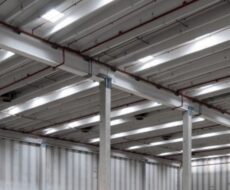
November 2, 2020
Seismic upgrades in an agri-food business
Carrying out a seismic retrofit in a company handling foodstuffs is a highly complex matter. What critical factors need to be taken into account? How is the work carried out? Let’s take a closer look together.
We carry out seismic work in companies working in a whole host of different industries: from engineering to manufacturing, from chemical to food.

Depending on what industry they belong to and their own individual structural features, each company needs a project planned on an ad hoc basis along with relevant special measures.
The critical factors of a seismic retrofit in the agri-food industry.When we do work on a company whose core business is processing foodstuffs, the main concern for us and for our client is that the work be done without in any way contaminating the environment we are working in.
As we have established, we only begin work once we have conducted an appropriate investigation and come up with an ad hoc plan for the work to be carried out that factors in the production site’s specific features, the aim of which is to have the least possible impact on the daily life of the company and its employees.
When it comes to working in companies whose business is food, we need to plan with even greater care, to the point where we often find ourselves having to come up with unique systems to suit the site’s requirements. A case in point is the job that the specialist Seriana teams carried out last month in a company of this type. Following an analysis of what was required, a very specific design choice led the team to work from the outside of the company, more specifically from the roof of the building.
 Carrying out a seismic retrofit in a company handling foodstuffs is a highly complex matter. How does Seriana S.p.A. tackle the work?
Carrying out a seismic retrofit in a company handling foodstuffs is a highly complex matter. How does Seriana S.p.A. tackle the work?
To dial up the safety of the work another notch — to be sure that the seismic improvement work was not going to produce contamination of any kind — the decision was made to take certain minor measures on the inside, too, before starting the project proper.
How does Seriana tackle the seismic retrofit of an agri-food business to bring it up to code?
So the team initially performed some work at night, when the company’s production site was idle, sealing every possible crack through which dust could potentially work its way in, as a result of vibrations, during work carried out from the roof.
The level of safety was then raised further as a precautionary measure by stationing one of our operators inside the building while the team worked from the roof to fit the fastenings. The appointed operator remained in constant radio contact with his colleagues on the roof so that he could live monitor proceedings to ensure that absolutely no dust was coming down that could contaminate the batches of food.
The advantages of Seriana S.p.A. seismic work
There are essentially two main qualities to the work carried out by Seriana S.p.A. following these procedures: on the one hand, we have the fact that the client company’s daily production activities are not affected in any way, allowing them to continue their business as usual and, at the same time, being able to guarantee that the workplace will not be contaminated in the process.
Both these elements are achieved thanks to an analysis and design phase carried out ad hoc by the team of Seriana engineers in the months leading up to the start of work on site.







